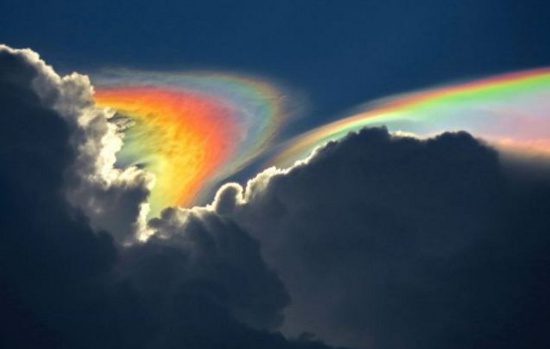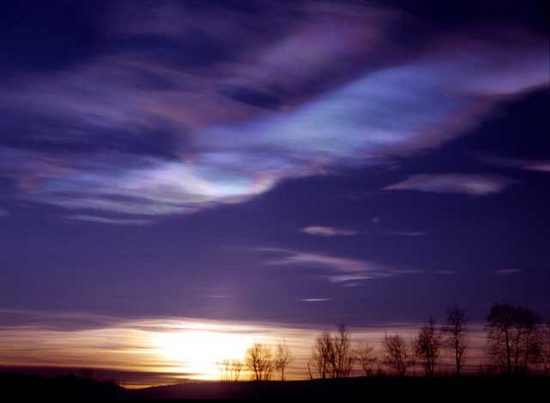Bioluminescent tides, glowing mushrooms, fire rainbows… are strange natural phenomena that few have had the chance to witness in person.
1. Bioluminescent Tides

The bioluminescent phenomenon within the waves is caused by phytoplankton.
Across the globe, there are many species of phytoplankton capable of bioluminescence. The most common bioluminescent species found in oceans is the dinoflagellate, a type of algae responsible for red tide phenomena. Dinoflagellates belong to the class of single-celled organisms.
Dinoflagellates float on the surface of the sea and move around in water currents, creating electrical pulses around proton particles, which prevent water from entering the microorganisms. These electrical pulses then create voltage-sensitive proton channels that trigger a series of chemical reactions, including the production of luciferase protein – responsible for forming the neon blue light inside the algae.
During the bioluminescent tide at Leucadia Beach, California in September 2011, scientists discovered some dinoflagellate species containing harmful toxins that could affect human health, as well as the reproductive processes of fish and other marine organisms. Furthermore, these algae utilize their bioluminescent ability as a powerful weapon against threats from other organisms.
2. Glowing Mushrooms

Glowing mushrooms are a toxic plant, also known as ‘ghost mushrooms’.
Researchers believe that mushrooms glow similarly to fireflies, thanks to a chemical mixture of luciferin and luciferase. Luciferase is an enzyme that facilitates the reaction between luciferin, oxygen, and water to create a luminescent solution.
However, as of now, there is no concrete evidence of luciferin and luciferase occurring in glowing mushrooms. The reason why these mushrooms exhibit luminescence remains an unsolved mystery. Scientists hypothesize that they glow to attract insects, helping them disperse spores to form new mushroom offspring.
3. Fire Rainbows

In reality, the phenomenon of fire rainbows has no relation to rainbows or fire. Fire rainbows are a special optical phenomenon that appears as a multi-colored band parallel to the horizon (also known as iridescent clouds). This occurs when clouds containing a substantial amount of water are nearly uniform in size. These clouds diffract or bend light, causing it to split into different wavelengths or colors.
4. Iridescent Clouds

Iridescent clouds resemble thin sheets that gently roll and unfold, spreading out and then contracting against the twilight sky.
Iridescent clouds typically form in extremely cold regions of the lower stratosphere, at altitudes of 15-25 km, just above the clouds of the troposphere. The reason they shine brightly before dawn and after sunset is that at these altitudes, they are still illuminated by sunlight.
This phenomenon is a direct consequence of humans releasing excessive amounts of methane into the atmosphere, reacting with ozone to form chlorine clouds. The appearance of iridescent clouds is a concerning sign indicating the Earth is gradually warming.
5. Snow Rollers

Snow rollers are an extremely rare natural phenomenon, occurring only with a harmonious combination of temperature, humidity, wind speed, terrain, and snow conditions.
These snow rolls form on flat or slightly sloped land, where the surface is covered by a smooth layer of ice or hard snow. Snow can fall or accumulate on the ground. Strong gusts of wind will lift the snow and roll it into cylinders.
Wet snow, freshly adhered to the icy surface, and newly formed snow rolls will slide and roll. The winds help move the snow rolls to make them thicker.
When the snow roll becomes too heavy for the wind to move or collides with an obstacle, it will cease to roll. Because they are only formed under specific climatic conditions, it is easy to understand why they are seldom encountered. Not only are they rare, but they are also very fragile. If the temperature rises or falls, they will collapse.
6. Basalt Column Forests

Basalt columns are formed due to volcanic eruptions, consisting of upright stone formations that create a spectacular geometric landscape, arranged in neat hexagonal patterns.
This fascinating natural rock formation is one of nature’s masterpieces located along the coastal region of Ireland.
7. Animal Rain

There have been strange rains where thousands of frogs fell from the sky onto the roads. Rain accompanied by other animal species is even rarer than ‘frog rain,’ but it has occurred in several countries around the world.
To explain this bizarre phenomenon, naturalists largely believe that during such events, a strong tornado swept up frogs and toads, carrying them over thousands of miles, and when the tornado weakened, the rain occurred, bringing these animals down to the ground along with the rain.
However, this is only one explanation for the occurrence of these strange rains. In reality, rain accompanied by the presence of ‘animals’ remains a mysterious phenomenon of nature that humans are still trying to explore.


















































